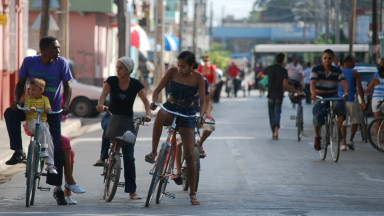A Public Trial in a Quiet Town

HAVANA TIMES — The Consul of Spain in Cuba, Tomas Rodriguez, described the trial of his countryman Angel Carromero as “clean, open and procedurally flawless,” one that had ensured the defendant received a fair deal and in which “the defense was very good.”
When we foreign journalists heard this summary, we could then breathe easy, because if we had made that same assessment ourselves, we would have been accused of being pro-Castro. Rodriguez, on the other hand, represents a politically right-wing government that opposes Havana.
The truth is that in the courtroom, the defendant was accompanied by the consul of his country and a lawyer sent from Spain by his family to advise the Cuban attorney, who — like the diplomat said — performed skillfully in the case.
In another room were us journalists. We were prohibited from bringing in recorders, laptops, cameras or cellphones; nevertheless, we were allowed to monitor the entire trial live on a TV screen. At the same time, our photographer colleagues sat around anxiously hoping to get a shot from the entrance of the court.
To the best of my recollection, such facilities weren’t provided to journliasts for the trial of Salvadorans who planted bombs in tourist hotels in the late 90s.
Hopefully this change will become policy so that trials will be truly public.

The first impression I had when seeing everyone dressed in heavy black robes was that I had stepped into a Harry Potter film, yet it didn’t take long to see that the judges as well as the prosecutor and defense attorney were very thorough in their work.
The prosecution attempted to prove that Angel Carromero was responsible for the accident, pointing to his impulsiveness, recklessness and poor driving abilities. All types of experts witnesses was called to the stand, including a biologist who testified as to the hardness of the tree into which the car slammed.
With the obvious attempt to sway the courtroom, a coroner was presented who described and showed photos of the condition in which the dissident leader Oswaldo Paya was found: his skull broken into five parts, nearly decapitated, his heart punctured and his kidneys having been turned to “mush.”
The defense attorney seemed interested only in the poor condition of the road, the location of the warning signs and the accuracy of the expert evidence. In the press room, impatient sighs were heard each time she returned to those points when cross-examining the experts.
She finally showed all her cards when, based on that questioning, she was able to refute some of those analyzes by demonstrating how events could have happened quite differently and by blaming the poor road signage for the tragedy.
I don’t know what effect this had on the judges, but this succeeded in planting seeds of doubt among us journalists. We then realized that this had been her strategy from the very beginning.
I jotted down her name. If I ever need a lawyer in Cuba, I’ll want her.
She requested the acquittal of her client, but from the beginning of the process she mentioned the possibility of a reduction in prosecution’s request for a seven-year sentence; instead she proposed that, if her client was convicted, he serve his time under house arrest in the residence of the consul of Spain in Havana.
The next day Oswaldo Paya’s widow made statements to the foreign press at the scene of the accident suggesting that there had been a conspiracy to murder her husband. “I don’t know if I’ll ever know the exact truth behind these things,” she said while standing next to the tree that caused her husband’s death.

Initially, the opposition and the family claimed that the car was pushed off the road by another vehicle. However, Carromero himself denied this, asserting that at the time of the incident all he saw was an approaching tractor over 200 meters away.
Pay’s widow and children traveled to Bayamo in a vehicle that apparently belongs to the Catholic Church. It’s a paradox because, prior to his death, Oswaldo Paya denounced the clergy for allying with the government to further marginalize the dissident movement.
The presence of the Paya family was the only political note of the trial. The prosecution didn’t use Carromero’s confession or that of his Swedish associate Aron Modig, in which they admitted to having traveled to Cuba to deliver money to dissidents and advise them in the creation of opposition youth groups.
Few memories about the trial will remain in the mind of the average Bayamo resident. Perhaps those locals most aware of the proceedings were the ones who had the facades of their apartment buildings repaired and painted to give a better picture of the city to foreign journalists.
On the morning after the trial, the city of Bayamo continued at the usual pace of its bicycles and horse-drawn carriages. People walked along the boulevard and the only gathering occurred in a store on Saco Street where bathroom flip-flops had gone on sale.
—–
(*) An authorized HT translation of the original published by BBC Mundo.
